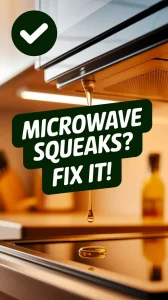A thermos, also known as a vacuum flask, is a storage vessel designed to keep drinks or food hot or cold by using insulation between two walls to curtail heat transfer.
The question we’ll be addressing here is whether it’s safe and effective to microwave such an items.
This article will delve into the composition of a typical thermos, exploring its capacity for withstanding microwave radiation. If microwaving is not advisable, we’ll discuss alternatives for heating contents stored in a thermos, along with any precautions you should take when doing so. Key facts about the construction of a thermos and how this impacts its interaction with microwaves will also be highlighted. Additionally, frequently asked questions on this topic will be answered and our final thoughts shared.

Jump To:
Is it Safe to Put a Thermos in the Microwave?
No, you cannot put a thermos in the microwave. Microwaving a thermos could potentially damage both your microwave and the thermos. The metal used in most thermoses can spark or cause arcing inside of the microwave which is dangerous. Similarly, other containers like glass or ceramic are more suitable for microwaving; they don’t have these risks associated with them. However, always ensure that any container you use is labelled as ‘microwave-safe’ before heating.
Check out if you can microwave a hydro flask.
Facts About Thermos
Here we will discuss the important things to note about a thermos.
- Material: Most thermoses are made of stainless steel or plastic with vacuum insulation, making them durable and efficient for keeping beverages hot or cold.
- Vacuum Insulation: The vacuum layer inside a thermos prevents heat transfer by conduction, which helps maintain the temperature of the stored beverage for longer periods.
- Thermal Efficiency: Thermoses are designed to keep liquids hot or cold for several hours. The efficiency is highly dependent on the quality and design of the product.
- Safety Measures: A microwave heats items by causing water molecules in them to vibrate; since there’s no water in that vacuum layer it can cause uneven heating which might lead to breaking or explosion.
In conclusion, due to their metal components and vacuum seal, placing a thermos into a microwave could be dangerous.
Check out if you can microwave a water bottle.
Now we will discuss some other things about microwaving a thermos.
What are the Alternatives to Microwaving a Thermos?
An alternative to microwaving a thermos is using a hot water bath. Simply pour boiling water into a bowl larger than the thermos, and place the latter inside making sure it’s fully submerged but not filled with water. This heat transfer method can gently warm your drink without risking damage to your thermos. Another substitute is direct stove-top heating if your thermos material allows for it. Alternatively, pre-heating beverages before pouring them in keeps them warm longer.
Check out if you can put a blender bottle in the microwave.
Tips for Attempting to Microwave a Thermos
Here are a few tips to avoid microwaving thermos:
- Avoid microwaving metallic or vacuum-sealed flasks as they could cause sparks or explosions.
- Prioritize glass or ceramics-based Thermoses since they are usually microwave-safe unless otherwise noted by manufacturers.
- If unsure of its microwave safety, check with manufacturer guidelines or consult product details found on websites and packaging labels.
- Never seal the lid while warming up; built-up steam may result in pressure build-up leading to potential harm.
- Microwave at short intervals and stir contents periodically for even heating and to prevent overheating certain sections of liquid.
We’ve discussed different methods of heating beverages in a thermos other than using the microwave and provided handy tips when opting for this often risky venture.
In our next section, we will be exploring frequent questions that arise from these topics.

Frequently Asked Questions (FAQs)
Let us now delve into some of the most commonly asked questions about microwaving a thermos.
Can I put a thermos in the microwave?
No, you cannot microwave a thermos. Microwaves heat food by producing radio waves which are absorbed by water, fat and sugar present in foods. These materials convert energy from the microwaves into heat. Metals such as those used for making thermoses reflect microwaves rather than absorbing them, leading to uneven heating or even causing sparks which may damage your appliance.
What could happen if I try to microwave a thermos?
If you try to microwave a thermos, it could lead to disastrous results such as sparking or damaging your microwave. The metal parts of the thermos reflect microwaves instead of absorbing them, resulting in uneven heating and potential safety risks.
Are there any safe alternatives for heating up my Thermospace?
A safe alternative for heating up contents in your thermos is transferring them into a microwave-safe container before placing them inside the oven. This way ensures that no harmful effects occur while still obtaining an evenly heated meal.
Is it possible to heat my drink directly into a metal travel mug in the microwave?
No, it’s not advisable to heat any liquid directly in a metal travel mug using a microwave oven because like with a standard steel flask or thermos, this can cause arcing and potentially start fires due to the reflection of microwaves off metallic surfaces.
We hope these frequently answered questions have helped clear any doubts regarding the use of thermal flasks within microwaves.
Final Word
In conclusion, one should avoid putting a thermos or any metal object into the microwave. Microwaves work by producing radio waves that are absorbed by water, fat and sugar in food but reflected by metals, thus leading to uneven heating or sparks damaging your appliance. Instead, transfer the contents of your thermos into a microwave-safe container before heating them.



